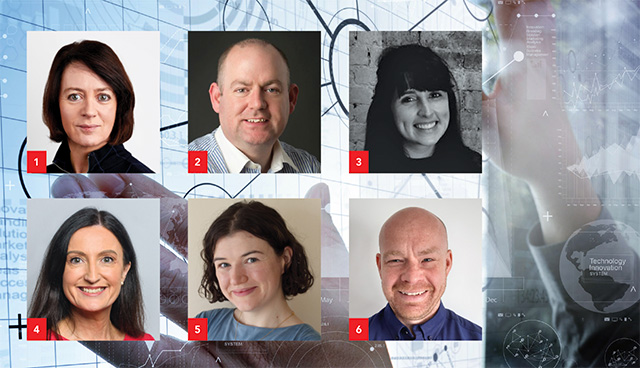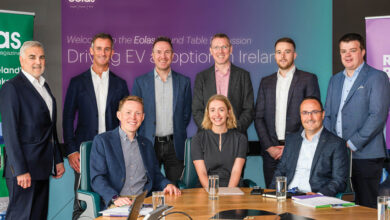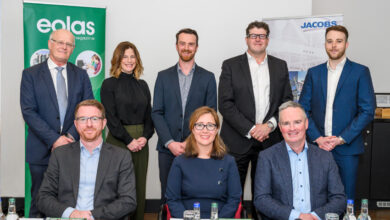Round table discussion: Connecting Ireland and the future of work

Vodafone Ireland hosted a virtual round table discussion with experts from across the public and private sectors, applying their experience and insight to explore the opportunity presented by the Covid-19 pandemic to implement new models of work for the future.
What are the key drivers of change in the future of work and how can we reimagine the way in which we work? What role will connectivity play?
Shelah McMahon
There are a range of drivers for the future of work such as technological advancement, increased digitalisation, and advanced workplace communication tools but the most seismic driver has been the pandemic. There has never been a timelier opportunity for us as a nation to review how we work and what we want the future of work to look like. Policy, culture, and tools are the key elements which will help us formulate the future of work and they are fundamental to the needs of the country to recover both socially and economically from the pandemic.
Deirdre Frost
Technology and broadband are drivers of change, but they are also the enabling infrastructure. The pandemic has served as a driver of change in terms of allowing people to experiment with what remote working might be like, albeit a forced experiment. Previous patterns have shown us that in a tight labour market, employees have more bargaining power and can therefore drive change. A further driver is the low carbon agenda. I think the benefits of remote working, in terms of reduced emissions, should be quantified to a greater extent and this should help inform the debate on both a micro and a macro level. Having analysed remote working for a long period of time, I’m interested to see what elements will gain traction and be sustained beyond the pandemic. Organisational culture and government policy will be critical to this.

“The emerging opportunity and shift of mindset ushered in by Covid indicates that work can be done elsewhere across the country.”
Tom Gilligan, Director of Services and Head of Finance, Mayo County Council
Tom Gilligan
The key drivers Mayo County Council has identified are technology, infrastructure, and people. Putting people at the centre of everything we do is a critical feature for local government, and we recognise a significant shift in the way we do business, which needs to be supported by policy, technology, and investment. We also recognise that we have a large cohort of staff whose roles do not easily lend themselves to remote working. To this end, there is an important leadership role in managing and engaging staff. The need to connect and collaborate will be even greater in the future and digital technology will be a key enabler.
Tracy Keogh
Technology, policy, and culture are the drivers we talk about when transitioning organisations, but we have also identified two additional layers which expand upon these. The first is the hard infrastructure in the form of broadband and hubs but the second is the importance of layering thriving eco-systems on top. We have a tiny window to maximise the opportunities of remote working presented by Covid. If you look at New Zealand, which has now exited lockdown, there has been a massive return to in-office working and so we must act swiftly if we are to capitalise on Ireland’s window.
Ruth Morrissy
Undoubtedly, Covid-19 has changed the world of work forever through the acceleration of existing trends such as digitalisation and technology adoption. One of the major drivers of remote working has been and will be employee demand. Generally, what we have experienced is not remote working to its truest extent; it has been emergency working from home. Despite this, in the Department’s interactions with the public, we are still observing strong interest in remote working continuing to some degree post-pandemic. Employers who embrace remote or flexible working practices are going to see benefits such as access to larger talent pools and improved staff morale. Underpinning policy, particularly in relation to connectivity, is also very important in this regard and that is why a major component of the Remote Work Strategy is focused on having the right national infrastructure in place.
Stjohn O’Connor
From a Civil Service perspective, the ability to attract and retain talent is a major driver. We are approaching a point in the Civil Service whereby a large portion of our senior management will be retiring within a short period of time. We need to adjust if we are going to continue to attract talent to work in the Civil Service; broaden the offering; and move away from the expectation of needing to be located close to Dublin.
How can a distributed model of working help to rebalance the economy and what are the benefits?
Tom Gilligan
The emerging opportunity and shift of mindset ushered in by Covid indicates that work can be done elsewhere across the country. Campaigns have been launched to bring people back to the west of Ireland. That will enhance the economy on the west coast, particularly in respect of our local towns and villages. It will also breathe new life into our communities and regenerate areas which have been in decline. It’s a great opportunity for people to reduce commuting times, to inject more flexibility into their day and to achieve a better quality of life. This is all conducive to Project Ireland 2040 which envisions a progressive population distribution strategy and the creation of much more balanced national economy.

“I am led to believe that there is already a slow and steady return to the workplace. If that is because of inertia, then we need to move to counteract that and consolidate remote work practices.”
Deirdre Frost, Policy Analyst and Project Manager, Western Development Commission
Deirdre Frost
Rural and regional development, as well as the ancillary spend that is associated with people living and working remotely or indeed working from a hub in rural areas, has to some extent been overlooked by concerns about Dublin city centre or other large urban centres.
The debate should not be reduced to an ‘either or’ discourse. In real terms, the proportion of people moving has a benefit for rural town centres that far outweighs any detriment to larger urban centres. At the same time, one key benefit to employers is an expanded labour supply. Whether they are urban or rurally based, they will have improved access to skills from a broader geographic area, which will be advantageous, especially in periods of high economic growth and tight labour markets.
Ruth Morrissy
Increasing participation in the labour market is a huge benefit, not only in terms of traversing geographical boundaries and reducing commuting times, but for the cohorts of people who typically have lower economic participation rates. These cohorts include people with disabilities and people with caring responsibilities who can benefit greatly from the elimination of the commute to work. It also helps attract older workers as they move towards retirement. The flexibility of remote working enables this cohort to remain in the labour market for longer, benefiting society as a whole. What is really striking about the benefits is how many of them are interlinked. For instance, if we can reduce commuting times, we can simultaneously reduce carbon emissions in the transport sector while improving the work-life balance of workers. The possibilities are huge.
Tracy Keogh
There is a gap between the rhetoric and the implementation of remote working policy. Without case studies and toolkits which support organisations to make the transition, we will be stuck in a loop of achieving consensus on the obvious benefits of remote working followed by little tangible action. When we talk about the benefits to communities, often the discussion sways towards repopulation and attracting people from east to west. Kate Lister, President of Global Workplace Analytics talks about remote working being an option for the top 7 per cent of employees. However, this does not produce positive outcomes for our rural communities. Instead, people on higher salaries move in and reduce affordability in these communities. There is much untapped potential in moving away from the top 7 per cent and providing career opportunities to the existing talent in rural and regional communities.

“Employers who embrace remote or flexible working practices are going to see benefits such as access to larger talent pools and improved staff morale.”
Shelah McMahon, Head of Public Sector Sales, Vodafone Ireland
Shelah McMahon
The distributed model of working also incorporates government policies, employer policies and employee policies. Likewise, culture is intrinsic to making this work. As the infrastructure becomes available, whether that be the collaborative tools to work from home or the creation of digital hubs, unless there are appropriate policies both from the organisations and the State, alongside an authentic culture which trusts and empowers people to work from locations other than fixed offices belonging to the organisation, it will not yield sustainable benefits. The opportunity to work remotely cannot merely extend to a privileged cohort that does not actually contribute to the social fabric of rural Ireland. Similarly, the distributed model of work will only achieve sustainable success if there is distributed equality of access to the digital skills which can capitalise on that opportunity.
Stjohn O’Connor
If you consider the research literature on building resilience in rural communities, one of the consistent themes is moving away from the traditional primary and secondary industries to establish a broader economic base. What we’re talking about here is an opportunity to achieve that, for the first time. It involves attracting different types of industry and jobs into communities to create a much more sustainable pathway to economic growth. From a community development perspective, there are far more people currently able to be involved in their communities because of the shift to remote working. That’s another redistributive effect for rural Ireland. Much of our society is built on volunteerism and people investing their spare time into local initiatives. When people are locked into a two-hour commute, it does not leave a lot of spare time for voluntary work.
What are the most significant obstacles to implementing new models of working?
Tracy Keogh
We developed a maturity model for organisations transitioning away from coping remotely to thriving remotely, which we split in to three groups: CEO leadership; people managers; and the rest of the organisation’s talent. In one organisation we worked with, we found that 90 per cent of staff said that they wanted to work remotely but 77 per cent of people managers said that they wanted people back in the office. What that tells us is that people managers need more support but also that this must be CEO-led because leadership is the missing component. A general understanding of the potential benefits is present but there is insufficient research into what is being lost in terms of collaboration and culture. The starting point must be case studies because fully remote has been tested and in-office has been tested but we have yet to fully evaluate a hybrid, remote first model at scale.

“There is a gap between the rhetoric and the implementation of remote working policy.”
Tracy Keogh, Co-founder, Grow Remote
Stjohn O’Connor
That community penetration is exactly why we are developing the national hub network because we see the value of leadership and we have been approached by companies who recognise the value the network will bring. The Western Development Commission will undertake a marketing campaign around the network, but we also recognise that it needs to be a bottom-up campaign. If we have 400 hubs on the network, they need to be actively promoting the availability of jobs and of a mechanism to attract those jobs into their communities. In addition, we would like to see a community dividend emerging from hubs in the network that would see them providing additional services to the community.
Deirdre Frost
To me the major obstacle is inertia and missing the opportunity to grow the remote workforce for the future, because at present we are working remotely in an enforced regime. Taking the point about New Zealand not seizing the remote working opportunity, Ireland could be the same if we do not act. I am led to believe that there is already a slow and steady return to the workplace. If that is because of inertia, then we need to move to counteract that and consolidate remote work practices. To do so, we need a better understanding. In the surveys conducted in partnership with the Western Development Commission and NUI Galway we see that for many people, their understanding of remote working is grounded in the emergency working from home model we have all experienced over the past year. I think we can take lessons from those countries who are more advanced in their response to the pandemic.
Stjohn O’Connor
One of the most interesting findings to have emerged from our surveys within the Civil Service was a widespread lack of knowledge of the third option; working in another facility such as a community hub. Part of our role is to disseminate that information but also to show leadership. We are awaiting approval on a proposal that would see existing OPW facilities around the country be transformed into remote working hubs for civil servants at very little cost. It is something I am keen to introduce because I think it would serve as a demonstration of how the public sector is embracing remote working opportunities.
Tom Gilligan
I think there are three identifiable obstacles. The first is culture and how receptive an organisation is to change. The second are the resources available to an organisation, including finance, skillsets, and infrastructure. The final obstacle is employee change fatigue. Employee change fatigue was an obstacle pre-pandemic, when it was recognised that constant introduction of new ways of working negatively impacted on staff morale and productivity. We have been through a substantial change in the last year and employee capacity for new ways of working needs to be a big factor of how we plan for the future.
Shelah McMahon
There is a critical role for leaders, whether they be private or public sector, not just to be the drivers of change but also to identify the various employee needs at different stages of their careers. Those entering the labour market will have a different requirement to those nearing retirement and that will be different again for those with caring responsibilities. Balance is key and crucial to finding that balance to deliver a future, successful way of working is asking the people who are going to deliver that model what they need and then delivering that through policy and culture changes.
Ruth Morrissy
Mindset and culture are significant challenges and I think as more people managers receive training, that will help to develop trust, as will the constant improvement of collaboration tools. One of the barriers we heard much about was the ability to switch off and the right to disconnect when remote working. Under the National Remote Work Strategy, the Workplace Relations Commission recently published a code of practice on the right to disconnect which will hopefully provide people with a lot more understanding of how the law will apply in these remote scenarios, helping both employers and employees.
How can new ways of working align productivity and engagement with a healthy work-life balance and what does this mean for rural communities?
Ruth Morrissy
In terms of productivity, there is a significant volume of research which provides a mixed picture on whether remote working is more productive or not. One significant piece of research undertaken by Microsoft polled 9,000 managers across 15 countries and found that remote working had been equally productive or improved productivity for the majority of companies. There are significant implications if people can get more work done in the same amount of time. It could help to prevent overworking or working later into the day. Paired with a reduced amount of time spent commuting, this will unlock much more time to be spent locally, increasing engagement within the community.
Deirdre Frost
The research we conducted was very consistent. The issue with productivity is the extent to which people are using extra time to do the same job, versus the time they have left over to invest in their local community. The Western Development Commission/NUI Galway surveys from 2020 indicate that people had much more free time because they were not commuting and some of this was spent working. This may be due to an initial learning curve whereby people were getting to grips with new ways of working or things were taking longer. However, one thing that is very clear is that at least some of that saved commuting time is being used to invest in individual wellbeing, community wellbeing and family wellbeing. That can only be a good thing.
Tom Gilligan
Alongside productivity, it’s about people and place. Our Rural Future, the recent government document that sets out several objectives to transform rural Ireland, encourages vacant properties to be brought back into use as community spaces and technology hubs. That will benefit the local community by enhancing access and therefore choice. Improved productivity is about ensuring that a task is completed in the most efficient manner possible. The new ways of working will help align with that objective. At the same time, in Mayo County Council, we have placed a particular emphasis on people’s mental wellbeing. Amid Covid, an increased number of people are working in isolation, inhibiting the collaboration traditionally associated with an office environment. Early on, at the start of my own career, I was advised to always take time and sit with colleagues from different sectors of my organisation. I learned a lot from that experience. People miss that aspect of work and we must be mindful as employers that we monitor mental wellbeing and ensure regular contact with colleagues as we implement new ways of doing things.
Shelah McMahon
This pivot towards new ways of working feels much more significant given the context of the pandemic. There must be a holistic focus on the wellbeing of the community of people who work within any given organisation. The wellbeing of the people availing of the distributed model of working is critical to the success of that model. The wider culture, inclusivity and diversity of an organisation will contribute to this success. One of the most interesting aspects of this conversation is that there appears to be a consensus that the tools and infrastructure are there. We must then layer on the public and private policies from the State and organisations, as well as cultures. These are the pillars for the delivery of the future of work, wherever you work and however you consume your services.

“From a community development perspective, there are far more people currently able to be involved in their communities because of the shift to remote working.”
Stjohn O’Connor, Principal Officer, Rural Development and Innovation, Department of Rural and Community Development
Stjohn O’Connor
There needs to be very specific research from within individual sectors as well as on a national basis as to where the dividend of remote working will be felt. Everyone knows that there are pervasive benefits across all sectors of society and the economy, but we have not yet reorientated the research to look specifically at each of those elements. We have spoken to the Western Development Commission about understanding the immediate economic impact on communities, but we must give broader consideration; to the carbon emission dividend, for example, and involve others such as the Department of Transport. In each of those areas, we need the policy experts to consider ‘what is the dividend, and can we put a price on it?’ Then we will start to see the full picture of remote working and articulating the vision will become a lot easier.
What lessons have been learned over the last year with enforced distributed working across the country, especially for those delivering state services to citizens and how citizens consume them?
Deirdre Frost
Amid this new enforced layer of digitalisation, we must extend the remote working dividend into wider society. I make that point because the Western Region and rural regions generally have a higher population in the economically inactive cohort. It strikes me that while many of the benefits of remote working may not have been properly quantified, it is very clear that they have been felt by the economically active. I am hopeful that these benefits will be felt by wider society, including those who are not in the labour force. In the context of the digital divide, many older citizens have improved their digital literacy. While this has occurred across vast swathes of the population, including through remote access to health services and education services, I am cognisant that the lessons and skills I and others have learned through remote working might not be universal.
Tracy Keogh
Grow Remote has observed that many people now have a personal experience of remote working and that experience informs their associations with the wider concept. If someone had a negative experience during the emergency working from home period, then they are likely to have a negative perception of remote working more broadly. Even when we discuss the remote first concept, some people say, ‘well, I want to be in the office sometimes,’ as opposed to recognising that it is location agnostic. To move past this, we need to broaden the perspective and avoid forcing a particular model upon individuals.

“Employers who embrace remote or flexible working practices are going to see benefits such as access to larger talent pools and improved staff morale.”
Ruth Morrissy, Assistant Principal Officer in the Department of Enterprise, Trade and Employment
Ruth Morrissy
The biggest lesson is that it can be done. Many organisations had a cultural mindset that they could not do it or that their roles weren’t applicable. Obviously, that is true in some very specific sectors. With organisations like the Civil Service, where previously there was not a significant volume of remote work being undertaken, it soon became apparent that many roles could be fulfilled from home with some ease. In terms of improving the delivery of state services, I spoke with my colleagues in the employment permits section to gather an understanding of how they have been transitioning with their workload. In the relatively short period of time of working remotely, these colleagues have replaced all the paper-based elements of their system and are now providing all their services digitally. There are significant benefits for applicants in that scenario as permits are now provided via email, which is faster and more reliable, improving overall customer service.
Stjohn O’Connor
The simple point is that it works. We have all adjusted and accelerated changes that were on the agenda for a long time but did not previously have enough momentum behind them to be implemented. We had no option but to make those changes which has resulted in rapid innovation. It has shown that we can change, develop, and try new things. There must be an acceptance of the need to plan for the future, recognising that we can change, and we can succeed. The greatest lesson from a Civil Service perspective is the willingness to innovate and to take risk. A window of opportunity now exists, and we need to seize the moment, driving changes that unlock ubiquitous benefits and avoiding a backwards slide into traditional patterns.
Tom Gilligan
One of the key lessons has been around communication. How, when and what we communicate with people is now more critical than ever. The second lesson concerns technology and skillsets. What we have learned is that it is important to adopt the most relevant technology and have the necessary skills to use it effectively. For instance, in Mayo County Council, we have launched a consultation portal around the new county development plan, providing people with the opportunity to submit their observations online. Consequently, this has injected a greater degree of flexibility into the process. Simultaneously, we must be conscious that there are certain cohorts of the workforce, particularly those in construction and manufacturing, which are still required to be on-site and cannot fully embrace the benefits and flexibility of remote working.
Shelah McMahon
The single biggest lesson for my team, and Vodafone Ireland more broadly, has been to experiment and learn fast. Amid the pandemic, we needed to be braver, and leadership was required to be more agile. Speed often trumps perfection. This has meant being open to making mistakes and learning from these. We were forced to do that over the last year and given the ongoing public health restrictions, that continues to be the case. Post-Covid, it would be a shame if we missed the opportunity afforded by the crisis to share socio-economic growth across the island of Ireland and instead regressed back to pre-pandemic working practices.
Round table participants
Deirdre Frost
Deirdre Frost is a Policy Analyst and Project Manager with the Western Development Commission. She has analysed and published on a range of policy issues relating to regional and rural development including the National Planning Framework and the National Development Plan. Deirdre is also Project Manager of ‘Digiwest’, a project delivering four rural working digital hubs in the western region. Since January 2020, she has led on a collaborative project with NUI Galway on the analysis and promotion of remote working which has undertaken several national surveys on remote working during Covid-19.
Tom Gilligan
Tom is a Director of Services and Head of Finance at Mayo County Council. Before joining Mayo County Council, Tom was the Head of Finance with the newly created Limerick City and County Council, the biggest change management programme in local government history. Prior to joining the public sector, Tom had roles in construction, retail, manufacturing, and the pharmaceutical sector. Tom is the holder of an MBA in Local Government and is the instigator and founder of VacantHomes.ie, an initiative of Mayo County Council on behalf of the Local Government Sector. Tom is also an author and recently published his first book Irish Drummers Volume One.
Tracy Keogh
Tracy Keogh is a co-founder of Grow Remote and a recognised international leader in the world of remote. Having over 10 years of experience in technology start-ups, Tracy spent the last few years building the largest local community of remote workers in the world. Working to change how employment spreads, she has spearheaded the delivery of training courses in remote to over 35 large enterprises, and 200 individuals.
Shelah McMahon
Shelah McMahon is the Head of Public Sector Sales at Vodafone Ireland. Shelah manages the central government portfolio and previously led public sector service management for Vodafone Ireland. Shelah has 25 years of experience across financial services and telecommunications with extensive experience of leading large teams and strategic change programmes. Shelah is passionate about connectivity and pioneering a gigabit society where public and private sector collaborate to democratise connectivity, which will deliver benefits to all citizens living and working in the island of Ireland.
Ruth Morrissy
Ruth Morrissy is an Assistant Principal Officer in the Department of Enterprise, Trade and Employment. Working in the Labour Market and Skills Unit, Ruth has led on several projects on remote work, such as the 2019 Remote Work in Ireland report, the creation of the Department’s Guidance for Working Remotely website, and the Department’s public consultation on the topic. Last year, she led the development of Making Remote Work, Ireland’s first Remote Work Strategy which was published in January 2021.
Stjohn O’Connor
Stjohn O’Connor is Principal Officer in charge of Rural Development and Innovation in the Department of Rural and Community Development. Stjohn has worked in a variety of departments and is currently responsible for building a national network of remote working hubs, delivering the Broadband Connection Points initiative of the National Broadband Plan, and working with local authorities to innovate with digital technologies. Stjohn holds a doctorate in governance from Queen’s University Belfast.






